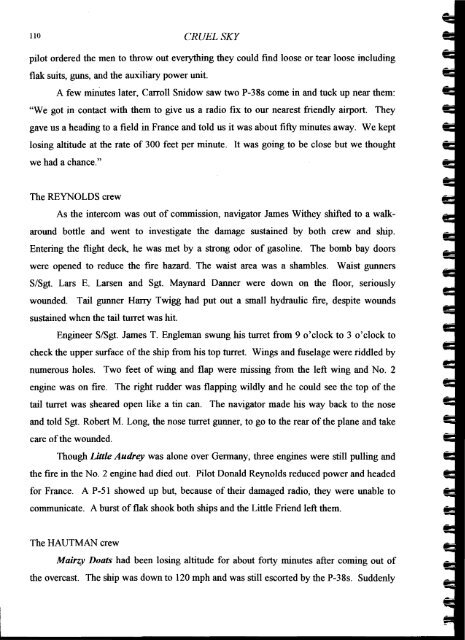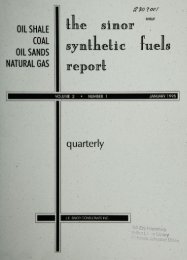Create successful ePaper yourself
Turn your PDF publications into a flip-book with our unique Google optimized e-Paper software.
110 C<strong>RUEL</strong> <strong>SK</strong>Y<br />
pilot ordered the men to throw out everything they could fmd loose or tear loose including<br />
flak suits, guns, and the auxiliary power unit.<br />
A few minutes later, Carroll Snidow saw two P-38s come in and tuck up near them:<br />
"We got in contact with them to give us a radio fix to our nearest friendly airport. They<br />
gave us a heading to a field in France and told us it was about fifty minutes away. We kept<br />
losing altitude at the rate of 300 feet per minute. It was going to be close but we thought<br />
we had a chance."<br />
The REYNOLDS crew<br />
As the intercom was out of commission, navigator James Withey shifted to a walkaround<br />
bottle and went to investigate the damage sustained by both crew and ship.<br />
Entering the flight deck, he was met by a strong odor of gasoline. The bomb bay doors<br />
were opened to reduce the fire hazard. The waist area was a shambles. Waist gunners<br />
S/Sgt. Lars E. Larsen and Sgt. Maynard Danner were down on the floor, seriously<br />
wounded. Tail gunner Harry Twigg had put out a small hydraulic fife) despite wounds<br />
sustained when the tail turret was hit.<br />
Engineer S/Sgt. James T. Engleman swung his turret from 9 o'clock to 3 o'clock to<br />
check the upper surface of the ship from his top turret. Wings and fuselage were riddled by<br />
numerous holes. Two feet of wing and flap were missing from the left wing and No. 2<br />
engine was on fife. The right rudder was flapping wildly and he could see the top of the<br />
tail turret was sheared open like a tin can. The navigator made his way back to the nose<br />
and told Sgt. Robert M. Long, the nose turret gunner, to go to the rear of the plane and take<br />
care ofthe wounded.<br />
Though Little Audrey was alone over Germany, three engines were still pulling and<br />
the fife in the No.2 engine had died out. Pilot Donald Reynolds reduced power and headed<br />
for France. A P-51 showed up but, because of their damaged radio, they were unable to<br />
communicate. A burst of flak shook both ships and the Little Friend left them.<br />
The HAUTMAN crew<br />
Mairzy Doats had been losing altitude for about forty minutes after coming out of<br />
the overcast. The ship was down to 120 mph and was still escorted by the P-38s. Suddenly















![pace SrntfletIc fne]its report - Alliance Digital Repository](https://img.yumpu.com/10493335/1/190x245/pace-srntfletic-fneits-report-alliance-digital-repository.jpg?quality=85)
